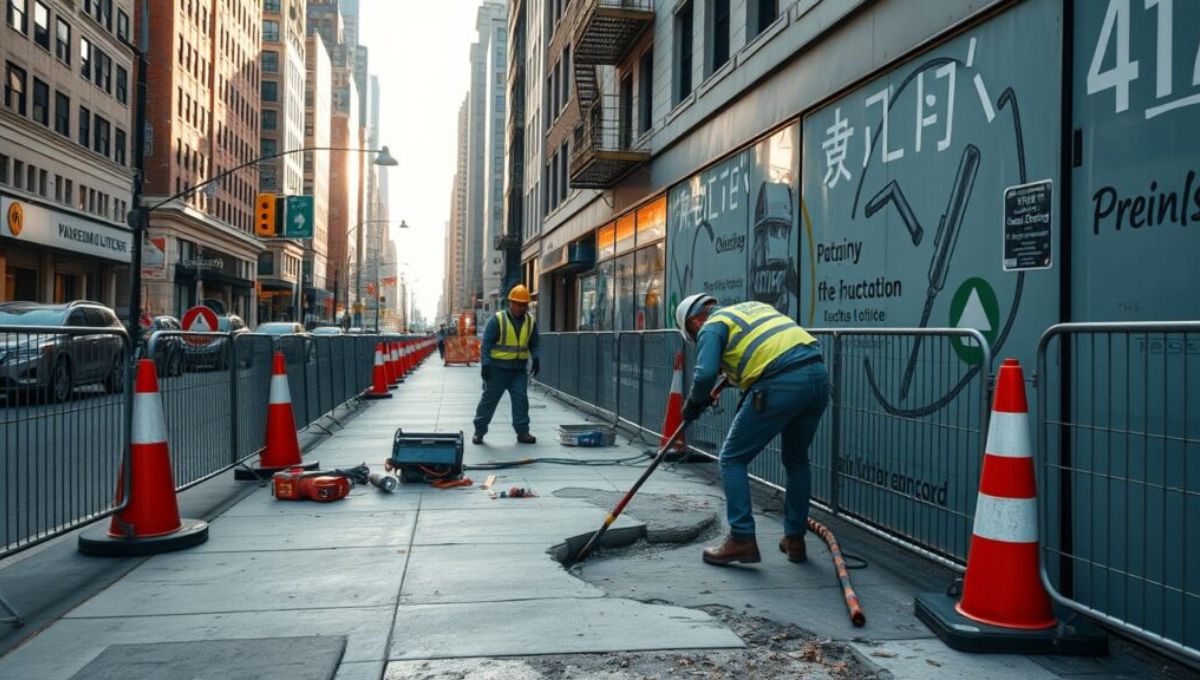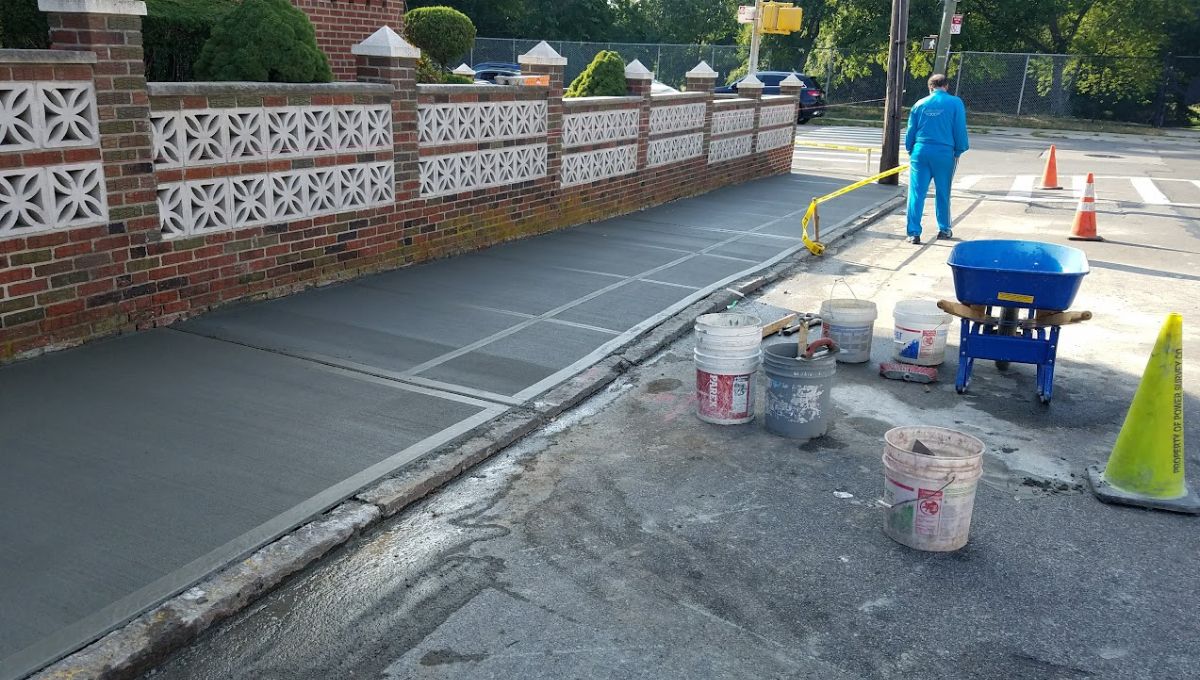Staten Island property owners know the frustration of receiving a sidewalk violation notice from the NYC Department of Transportation. With over 12,000 miles of sidewalks throughout New York City, maintaining these concrete pathways represents a significant responsibility for property owners. Sidewalk repair services in Staten Island have evolved considerably in recent years, incorporating new materials, techniques, and compliance standards that make repairs more durable and cost-effective than ever before.
The borough’s unique geography, from the hilly terrain of Todt Hill to the waterfront areas prone to shifting, creates specific challenges for sidewalk maintenance. Understanding these local factors, along with the latest repair trends and DOT requirements, can save property owners thousands of dollars while ensuring their sidewalks remain safe and compliant for decades to come.

Understanding NYC DOT Sidewalk Violation Notices
The NYC Department of Transportation issues sidewalk violation notices when inspectors identify hazardous conditions that could pose safety risks to pedestrians. These violations typically fall into several categories: cracked concrete that creates tripping hazards, uneven surfaces with height differences exceeding three-quarters of an inch, and deteriorated areas where the concrete has crumbled or developed significant holes.
Property owners who receive these notices have 75 days to hire qualified sidewalk repair contractors and complete the necessary work. Failing to address violations within this timeframe can result in the city performing the repairs and billing the property owner at premium rates—often three to four times the cost of hiring private contractors.
The NYC Department of Transportation maintains strict standards for sidewalk repairs, requiring all work to meet specific thickness, slope, and material requirements. These regulations ensure that repaired sidewalks provide adequate drainage, accessibility compliance under the Americans with Disabilities Act, and long-term durability in New York’s challenging climate conditions.
Common Sidewalk Problems and Their Causes
Staten Island’s sidewalks face unique challenges that contribute to deterioration over time. Tree root growth represents the most common cause of sidewalk damage, as mature trees can exert tremendous pressure on concrete slabs, causing them to crack, lift, or shift. The borough’s abundant tree canopy, while beautiful, creates ongoing maintenance challenges for property owners.
Freeze-thaw cycles during winter months compound these issues, as water penetrates existing cracks and expands when it freezes, widening gaps and accelerating deterioration. Staten Island’s proximity to salt water also means that concrete faces additional corrosion from salt spray and moisture, particularly in coastal neighborhoods like Great Kills and Tottenville.
Heavy vehicle traffic, construction activities, and natural settling of the ground beneath sidewalks can create additional stress points. Poor drainage around sidewalk areas allows water to pool and seep into the concrete’s foundation, weakening the structure over time and creating the conditions for more extensive damage.
Latest Trends in Sidewalk Repair Materials and Techniques
Modern sidewalk concrete repair has embraced several innovative approaches that deliver superior results compared to traditional methods. Polymer-modified concrete represents one of the most significant advances, offering enhanced flexibility and durability that better withstands freeze-thaw cycles and ground movement. This material costs slightly more upfront but provides significantly longer service life, making it cost-effective over time.
Rapid-setting concrete formulations have revolutionized project timelines, allowing contractors to complete repairs and reopen sidewalks to pedestrian traffic within hours rather than days. These quick-cure materials are particularly valuable in busy commercial areas where extended closures would impact business operations.
Tree root barriers have become standard practice in areas where root intrusion caused the original damage. These underground barriers redirect root growth away from new concrete while allowing trees to thrive, preventing recurring damage that previously required repairs every few years.
The International Concrete Repair Institute has developed new best practices for surface preparation and bonding agents that ensure repairs integrate seamlessly with existing concrete. These techniques eliminate the weak points where old and new concrete meet, creating repairs that last as long as the original installation.
Cost Factors for Sidewalk Repair Services in Staten Island
Several variables influence the total cost of sidewalk repairs, with project size representing the most significant factor. Small spot repairs addressing individual cracks or small damaged sections typically cost $8-12 per square foot, while larger projects benefit from economies of scale that can reduce per-square-foot costs.
Complete sidewalk replacement projects range from $12-25 per square foot, depending on site conditions, material choices, and accessibility factors. Properties with challenging access, such as narrow yards or steep grades, may incur additional charges for equipment access and material transport.
Material costs have increased substantially in recent years, with standard concrete mix rising approximately 15-20% since 2020. However, property owners can often offset these increases by choosing contractors who purchase materials in bulk and pass savings along to customers. Premium materials like polymer-modified concrete add $2-4 per square foot but provide enhanced durability that justifies the additional investment.
Permit fees and inspection costs add $200-500 to most projects, depending on scope and complexity. Properties in historic districts or areas with special zoning requirements may face additional regulatory costs that sidewalk repair contractors must factor into their pricing.
How to Choose Reputable Sidewalk Repair Contractors
Selecting qualified contractors requires careful evaluation of credentials, experience, and local knowledge. All legitimate sidewalk repair contractors must carry proper licensing through New York State and maintain comprehensive general liability insurance with minimum coverage of $1 million. Property owners should always request proof of insurance and verify that policies remain current.
Experience with NYC DOT requirements is crucial, as contractors unfamiliar with local regulations may complete work that fails inspection, requiring costly corrections. Ask potential contractors for references from recent Staten Island projects and verify their familiarity with local soil conditions, climate challenges, and permit processes.
Established contractors typically provide detailed written estimates that break down material costs, labor charges, permit fees, and project timelines. Be wary of estimates that seem unusually low, as they may indicate corners being cut on materials, labor quality, or regulatory compliance.
The Better Business Bureau maintains records of contractor complaints and resolutions that can provide insight into a company’s reliability and customer service practices. Additionally, contractors who belong to professional organizations demonstrate commitment to industry standards and ongoing education.

Step-by-Step Guide to the Sidewalk Repair Process
Professional sidewalk repair follows a systematic process that begins with thorough site assessment and damage evaluation. Contractors examine not only visible damage but also underlying conditions that may have contributed to the deterioration, such as poor drainage, root intrusion, or foundation settling.
Site preparation involves careful removal of damaged concrete, typically using specialized equipment that minimizes vibration and prevents damage to adjacent structures. Proper excavation ensures that new concrete has adequate thickness and proper base preparation for long-term stability.
Foundation work may include installing root barriers, improving drainage, or addressing soil compaction issues that contributed to the original damage. This preparatory work represents a crucial investment in preventing future problems, even though it adds to immediate project costs.
Concrete placement follows NYC DOT specifications for thickness, reinforcement, and finishing techniques. Professional contractors use proper curing methods that allow concrete to achieve full strength while minimizing cracking during the hardening process.
Final inspection by DOT officials confirms that completed work meets all regulatory requirements, officially closing violation notices and protecting property owners from future liability.
Maintaining Your Sidewalk to Avoid Future Issues
Preventive maintenance significantly extends sidewalk life and reduces long-term repair costs. Regular cleaning removes debris and organic matter that can retain moisture against concrete surfaces, accelerating deterioration. Property owners should address small cracks promptly with appropriate sealers before water penetration causes more extensive damage.
Tree maintenance plays a crucial role in sidewalk preservation, particularly pruning roots that grow too close to concrete surfaces. Professional arborists can assess root systems and recommend interventions that protect both trees and sidewalks.
Proper drainage around sidewalk areas prevents water accumulation that weakens concrete foundations. This might involve adjusting grades, installing drainage systems, or redirecting downspouts away from sidewalk areas.
Winter maintenance requires careful attention to de-icing practices, as some chemical de-icers can accelerate concrete deterioration. Property owners should use products specifically designed for concrete surfaces and apply them sparingly to minimize chemical exposure.
Ensuring Long-Term Success with Professional Sidewalk Repair Services in Staten Island
Staten Island property owners who invest in quality sidewalk repair services in Staten Island protect both their properties and their communities. Professional repairs that meet NYC DOT standards provide safe pedestrian access while avoiding the costly penalties associated with violation notices.
The evolution of repair materials and techniques means that modern sidewalk repairs last longer and perform better than ever before. Property owners who choose experienced sidewalk repair contractors and invest in quality materials enjoy decades of trouble-free service from their sidewalk investments.
For Staten Island residents seeking reliable, compliant sidewalk repair services, NYC Sidewalk Repair combines extensive local experience with the latest repair techniques and materials. Our team understands the unique challenges facing Staten Island properties and delivers solutions that meet NYC DOT requirements while providing exceptional long-term value.
